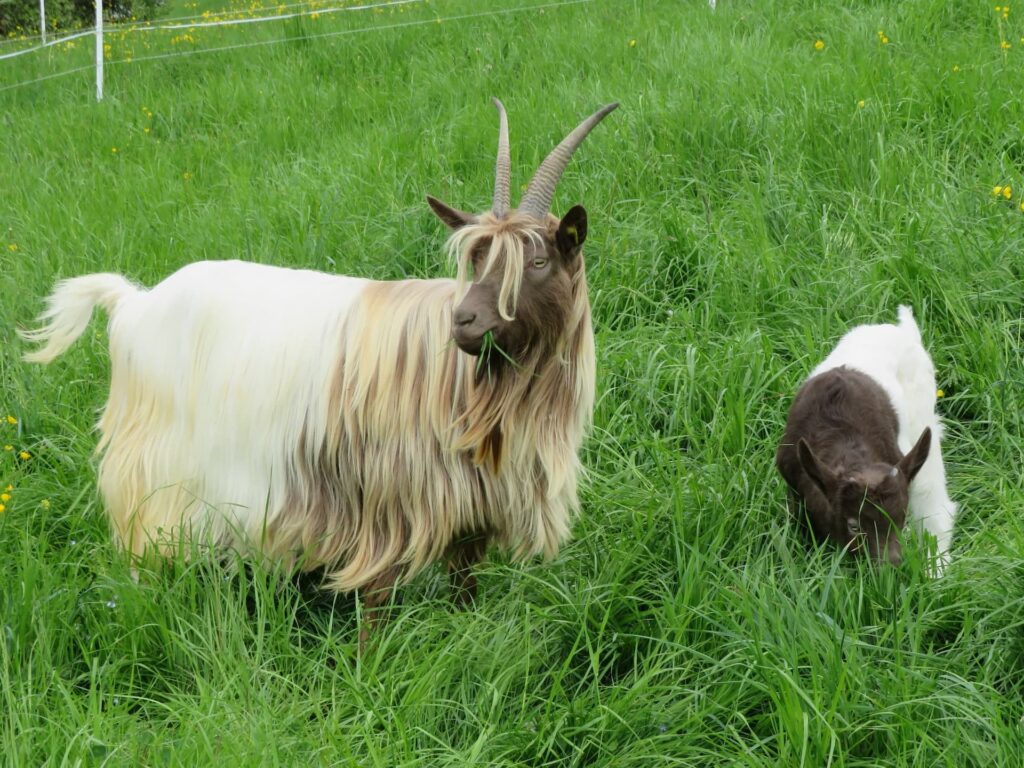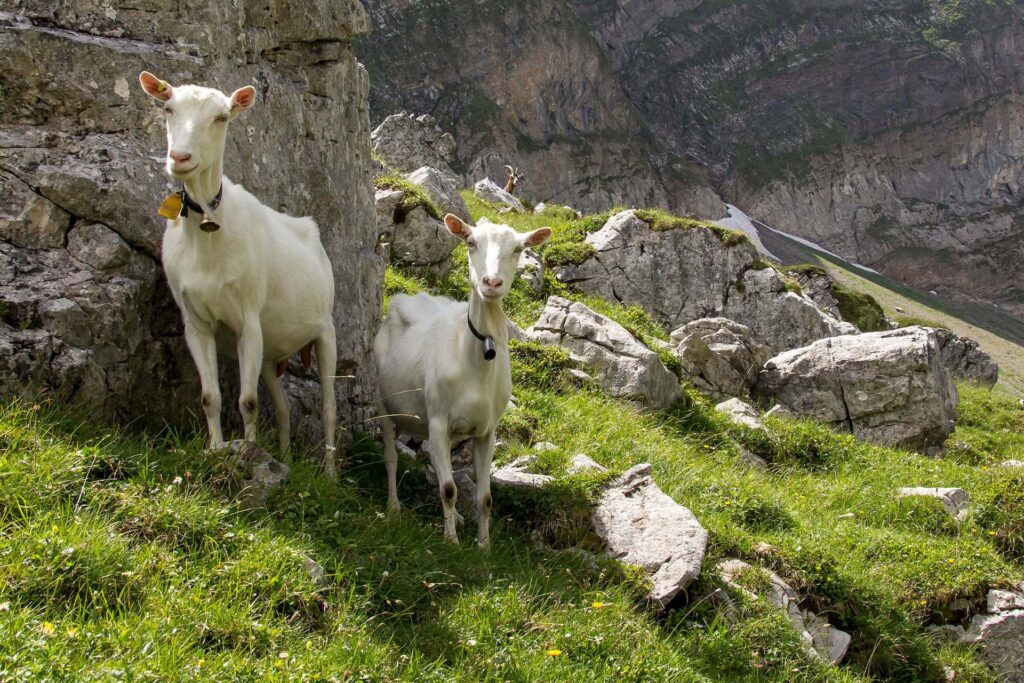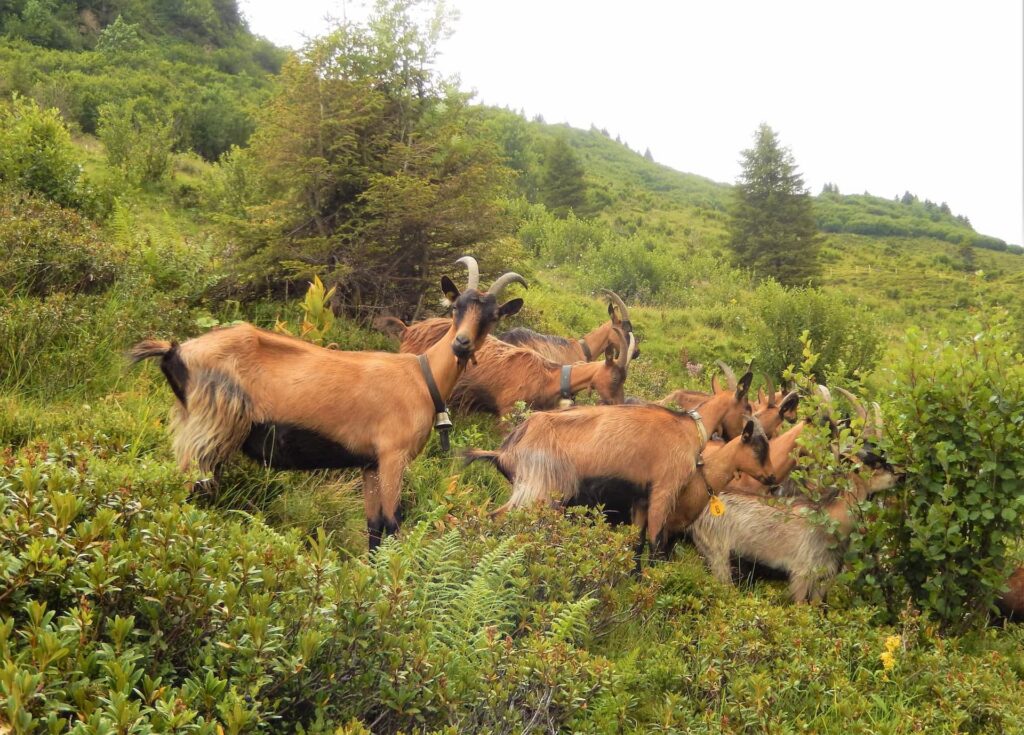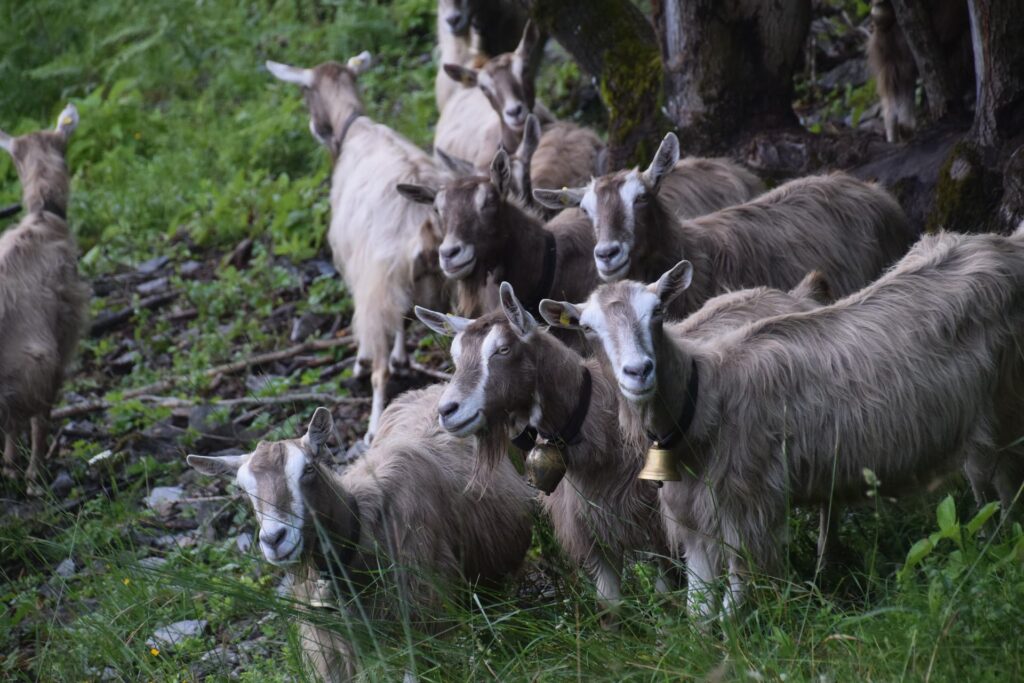Swiss goat breeds

Appenzell goat
The white, long-haired Appenzell goat is still part of the tradition and culture of the cantons of Appenzell Innerrhoden and Appenzell Ausserrhoden. To this day, a herd of Appenzell goats leads the annual processions up to and down from higher ground. Despite their good milk yield, their numbers are in a state of continual decline.
The breed is traditionally bred with a wattle (fleshy appendage attached to the throat).
Bündner Strahlenziege
The Bündner Strahlenziege, also referred to in English as the Grisons Striped goat, originates from the canton of Graubünden and owes its name to the distinctive white markings on its head. The goat also has white markings on its legs and tail, but is otherwise black. While it is primarily kept for its milk, it is also farmed for its meat. It produces attractive milk yields even when on the move in steep terrain that is not very rich in forage. As they are very adept in the mountains, they also prevent impassable terrain from becoming overgrown.


Capra Grigia
The Calanca, Leventina, Valmaggia and Riviera goats were left with a bleak outlook in the 1938 review of Swiss goat breeds: they were not recognised as breeds and were thus not considered indigenous to Switzerland, meaning their numbers decreased drastically. In the 1990s, ProSpecieRara became aware of their predicament and launched a rescue project. However, this project was not aimed at the individual types, but rather for all of them together under the name “Capra Grigia”, which is Italian for “stone goat”. Since 2006, the breed has also been officially recognised as a Swiss goat breed. The name refers to the coat colour, which can vary from silver to dark grey. A striking feature of this breed are the strong horns found on both sexes. Thanks to their colour, this breed is adept at hiding in the mountains, a quality that has been important for protecting their offspring from predators but which has also represented a challenge for herders at times. The Capra Grigia can be kept as a mother goat, for milk production and as a means of protecting against scrub encroachment.
Sempione
The origin of the Sempione lies in the Simplon region, which gives the breed its name. In the Valais dialect, it is also referred to as the “Simplerziege”, or “Simplon goat” in English. In contrast to its sister breeds, which comprise the Valais Blackneck, the Grüenochte Geiss and the Copperneck goat, its coat is pure white and not bicoloured. They are primarily kept for their meat. In addition, they help to keep the landscape open. While the breed was not recognised as a separate breed in the 1938 review of Swiss goat breeds, it was in Italy. When ProSpecieRara came across the breed, there were still 47 in Switzerland and slightly fewer in Southern Germany. In 2022, the Sempione was the rarest goat breed in Switzerland, with just 33 animals being registered in the herd book. A small herd book population indicates that the available genetic base is limited, meaning that special attention must be given to the relationship of the animals during breeding.


Chamois Coloured mountain goat
The most common goat in Switzerland today is the Chamois Coloured mountain goat. Its prevalence can be attributed to its good milk yield and above-average levels of milk constituents. The goats are also considered to be very adaptable and produce a good milk yield even when kept extensively. There are two types of the Chamois Coloured mountain goat. While both have a smooth brown coat, the hornless Oberhasli-Brienz type is primarily found in the Bernese Oberland and the Gruyère region, whereas the horned type is mainly at home in the cantons of Graubünden and Uri.
Grüenochte Geiss
The “Grüenochte Geiss”, much like the Valais Blackneck and Copperneck goat, is a breed from Valais with different colourings on its forequarters and hindquarters. The front half of its body is grey-black-white mottled. There is historical evidence that this breed used to be more common in Valais. It is one of the rarest goat breeds in Switzerland and exhibits the typical slender build of Valais goats. In 2022, some 39 Grüenochte Geiss were recorded in the herd book. A small herd book population indicates that the available genetic base is limited, meaning that special attention must be given to the relationship of the animals during breeding.


Copperneck goat
Like its sister breeds, namely the Valais Blackneck and the Grüenochte Geiss, the Copperneck goat has a characteristic bicolouration. However, the colour change takes place at the front of the body, rather than on the last rib as is the case with the Valais Blackneck. In 2006, there were just 28 Copperneck goats in the Bernese Oberland and Valais. ProSpecieRara, a foundation dedicated to the preservation of the genetic diversity of plants and animals in Switzerland, thus took on a project to save this breed. Since this time, the herd book population has increased to 179 (2022). A larger herd book population means that more animals are now available for breeding and is important for the long-term preservation of the breed. The rescue project is focussing on the old type, meaning the breed standard specifies a somewhat shorter and thus more manageable coat.
Nera Verzasca
The pure black goat breed originates from the Valle Verzasca in the canton of Ticino. Today, it is still primarily found in Ticino and Italy. The Nera Verzasca is highly endangered and in Switzerland has the lowest population of all the milk-producing breeds. The robust and strong animals help to push back bushes and trees and maintain the open landscape. The breed is kept for both its milk and meat.


Peacock goat
Typical for this breed are its striking markings: the front half of the Peacock goat is white with black feet, while the back half of its body is black with white thighs. A further striking feature are the breed’s “Pfaven”, the Romansch word used to denote the black markings over its cheeks. And it was this feature that gave the goat its original name of the “Pfavenziege”. It is believed that a reporter’s spelling error led to the goat’s current name of the “Pfauenziege”, which is where its English name comes from. The markings are still referred to as “Pfaven”, however. The rather large and heavy goat boasts good stamina and produces an impressive milk yield. However, it is also kept for its meat.
Saanen goat
The pure white Saanen goat originates from the Saanenland and Obersimmental regions in the canton of Bern. Their high milk yield is appreciated by breeding farms in both Switzerland and abroad. This quality and the fact that their propensity to move is less marked than other goat breeds is likely to have contributed to the fact that their numbers have not declined to the same extent. Saanen goats are therefore well suited for being kept in larger herds. In Switzerland, the Saanen goat is the second most common breed after the Chamois Coloured mountain goat.


Booted goat
This goat breed’s name comes from the brown or black fur “boots” found on it legs. Accordingly, it is possible to find both “black-booted” and “brown-booted” types. The coat colour of both types ranges from light or dark brown to silver-grey. Typical features of this breed are the long hairs on its back (“Mänteli”) and hindquarters (“Hösli”). All members of this goat breed have horns. If you don’t look carefully, it is possible to confuse the Booted goat with the “Chamois Coloured mountain goat”. Booted goats are ideal for controlling scrub found in remote pastures. They are also good and enthusiastic climbers. They often have twin births and in most cases also have sufficient milk to feed their young.
Toggenburg goat
Originally from Toggenburg, as the name suggests, this breed is now found throughout Switzerland and also abroad. However, whereas in Switzerland the long-haired type is more common, preference is given to its short-haired counterpart abroad. The breed’s colour varies from light brown to mouse grey. Typical of the breed are the white markings that have become known as “Swiss markings” in English-speaking countries. The long hair on its back and over its thighs is referred to as a “Mäntelchen” or “Hosen”, which translates as “little coat” or “pants” in English. Traditionally, Toggenburg goats have been kept with other livestock, which may also explain the great trust they show in the presence of dogs or large cattle.


Valais Blackneck
The Valais Blackneck is one of the oldest domestic goat breeds in Switzerland. It is said to be descended from animals that came to Valais during the immigration of African peoples in the year 930. It stands out due to its clearly separated black and white colouring and its differently twisted horns. While its long hair protects the Valais Blackneck from the harsh climate, it also needs appropriate care. Together with the Copperneck goat, the Grüenochte Geiss and the Sempione, it belongs to the “Valais goat group”. However, only the Valais Blackneck was included in the list of recognised Valais goats as part of the 1938 review of Swiss goat breeds. Today, the populations of the other three breeds are therefore only few in number.

